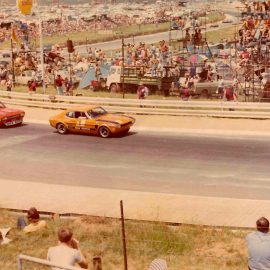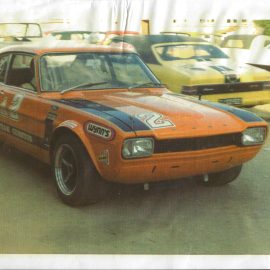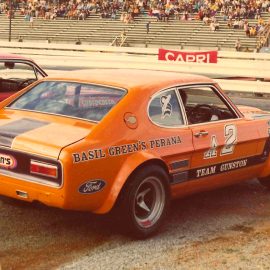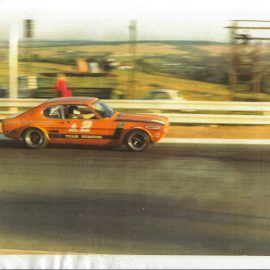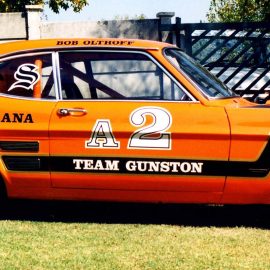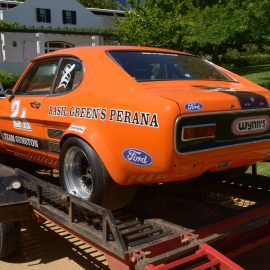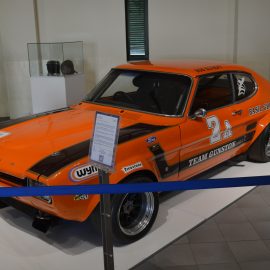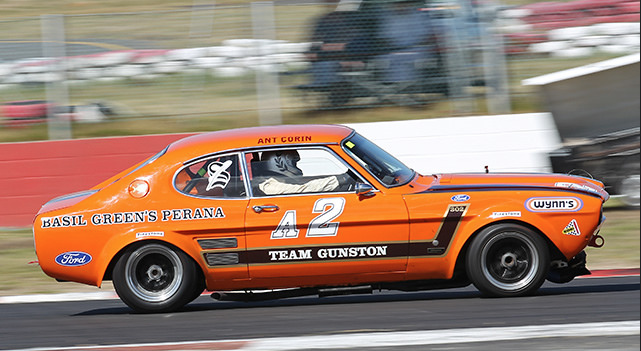
05 Dec The Team Gungston Capri
In motoring folklore, South Africa is notable for having developed and produced some rather special and unique motor cars over the years, generally with a sporting bent. Almost all carried a level of sophistication that characterised the engineering talent that existed in the country, despite its isolation at the time. One such machine was the Capri Perana, a muscle car built out of Ford of Europe’s stylish new coupe. The Perana was the brainchild of Johannesburg garage owner and tuning specialist Basil Green and became one of only two independently manufactured cars ever built with the full blessing and back-up of Ford: the other was Carroll Shelby’s Cobra.
The Capri Perana project came about in the late 1960s when Ford SA was sponsoring Bobby Olthoff internationally with the Willment team. Locally, the company was running a Falcon but it was not performing so well and something more competitive was sought, especially with the knowledge that arch-rival General Motors SA was bringing in the powerful Holden Monaro too. By this time Green had successfully developed the Mk.2 Cortina Perana V6 both as a road and race car and had got to know Ford’s top brass through the Grosvenor Ford dealership, which was the main selling outlet for the Peranas. Ford asked Green to put something together and so he went to Port Elizabeth to discuss the options. The Capri – advertised as being ‘The car you’ve always promised yourself’ – had just been launched locally and Green measured it up and asked for some parts to build a prototype. Ford SA top brass Ron Scott and Spence Sterling enthusiastically backed Basil’s proposal and promised full financial backing.
Basil set up new premises in Plantation Road, Edenvale and the prototype build to the then Group 5 regulations commenced using a load of parts from Ford’s GT40 Le Mans car. The right-hand drive steering rack had to be changed to accommodate the Gurney-Weslake 302ci (4 948 cc) V8 that was fitted with a high-rise manifold, four-barrel Holley and a BG camshaft and mated with Ford’s four-speed TopLoader gearbox. Together with the brakes and wheels, the front suspension was replaced with GT40 items. A 9-inch limited-slip diff was also fitted. With wheelarches flared and the bodywork painted in Team Gunston’s distinctive burnt orange with contrasting striping, Z181 (the car’s allocated race number for the new season) was ready to do battle.
The outcome? Total domination! Olthoff and the Perana won the championship by winning 12 of the 1970 season’s 13 races with the single failure being a DNF due to a broken crankshaft. The stage was set, but either by coincidence or design, for 1971 the racing rules were changed to the more production-based Group 2 formula. But the Perana remained dominant and Olthoff won the Star Production Championship title again in his ‘works’ Class A Team Gunston car – race number A2 – fending off competition from the likes of Basil van Rooyen and Peter Gough in similar cars. (Koos Swanepoel raced the car in 1972 in Team Grosvenor livery after Olthoff retired.) The Team Gunston car featured unique, C-shaped rear leaf springs that allowed the wide (14,5-inch) Gp.5 wheels and tyres to be fitted within the narrower wheelarch flares prescribed by the Gp.2 regulations, a ‘bending’ of the rules that irked the privateers (especially Van Rooyen) but was deemed legal by race scrutineers. Suspension location points had to be standard, but additional dampers were fitted to help make the front end incredibly stiff.
The 1971 Group 2 car belongs to, and is still occasionally raced – with its original engine block! – by Anthony Corin and is the only survivor of the six original Gp.2 Peranas. Post-1972 the car was owned and raced in Zimbabwe by Ron Lupson then Ray Yeo before a tip-off led Nick Sheward to the by now abandoned car. Nick set about meticulously restoring A2, including the use of an original spare set of Team Gunston decals! The original paint colour charts were found and matched, too. Nick then sold it to Graham Rooke, from whom Anthony purchased the car in November 2007.
As with the Gp.5 car, the Gp.2 Perana features a high-rise manifold, 600 CFM Holley carb, special porting of the cylinder heads including bigger valves, and a ‘wild’ Basil Green racing camshaft. The rules stipulated the use of the standard crank, con-rods and flat-topped pistons. The motor puts out around 250 kW at 6 000 r/min and, depending on the gearing, a top speed of around 270 km/h.
The Team Gunston Ford Capri Perana A2 is one of the few period original and historically documented South African race cars from the golden era of local motor sport. FMM is honoured to have the A2 on display in FMM’s Hall D until 31 March 2025.
GUNSTON SPONSORSHIP
On a historical note, Gunston was the first cigarette manufacturer to sponsor a Formula 1 team, but not F1’s first team sponsor as is believed by many. BRP (British Racing Partnership) was the first F1 team to be sponsored when hire-purchase company Yeoman Credit Ltd bought into the team in August 1959. The following season, the team’s Coopers were entered by Yeoman Credit Racing. This only lasted a year after some tragic events took place in the sport, and the team was passed to Reg Parnell who obtained sponsorship from UDT Laystall for 1961 and ’62. United Dominions Trust was a holding company of which Laystall Engineering was a part. Gunston was the next sponsor into F1 when it entered a Brabham BT20-Climax for John Love and an LDS Mk.3B-Repco for Sam Tingle in the 1968 South African GP. What made Team Gunston special was that the cars were the first to be liveried in the sponsor’s colours: the distinctive burnt orange with brown striping was to become one of the most recognisable looks in motor sport.




